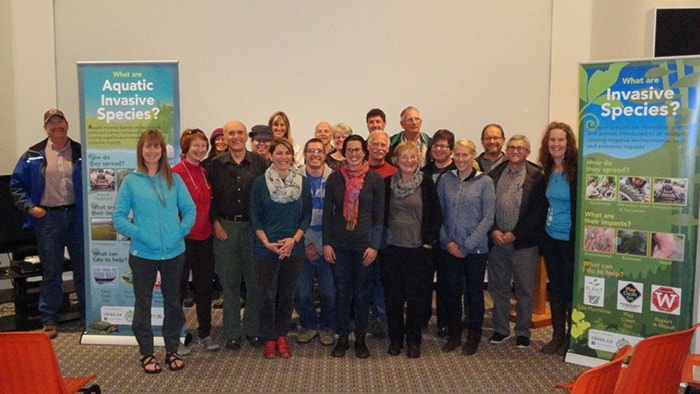The Central Kootenay Invasive Species Society’s (CKISS) Annual General Meeting took place on September 16 at the Creston Valley Wildlife Management Area.
The day kicked off with a Drone demo from Nelson based company Harrier Aerial Surveys. Drones are quickly emerging as a valuable tool used in ecological research. In spring 2015 drones were used to map the problematic swath of Yellow Flag Iris (YFI) that hugs several waterways at CVWMA. The flower is an escaped garden ornamental that out-competes and displaces native plants causing wildlife habitat degradation.
Thompson River University (TRU) in Kamloops is currently conducting research on control methods for Yellow Flag Iris. The University is researching the efficacy of thick rubber matting (benthic membrane) as a control method for YFI. Participants were able to see first-hand several research plots that exist throughout the wetland area. This past spring and summer CKISS has been sampling these plots and sending them to TRU for analysis. Through modern technology Catherine Tarasoff, Ph.D., P.Ag, an Adjunct Professor in the Department of Natural Resources at TRU, was able to Skype into the event and offer insight into her research.
Marc-Andre Beaucher, head of operations for the wildlife management area and Terry Anderson, Ministry of Forest Lands Natural Resources Operations habitat officer gave a presentation on the threats that American Bullfrogs can have to wetland biodiversity. They stressed that early detection and rapid eradication is imperative because bullfrogs out-compete BC’s native species like the endangered northern leopard frog.
“A female bullfrog can lay up to 20,000 eggs vs. 3000 to 5,000 for a female leopard frog,” Beaucher said. “Bullfrogs can easily overrun the system and they are also very voracious, they’ll eat just about anything that fits in their mouths.”
It is well known by wildlife officials that bullfrogs run rampant in Idaho and Washington. A bullfrog surveillance program was set up this past summer by CKISS to investigate if any of these pesky critters had made their way to the Kootenays.
“As part on an early detection rapid response surveillance system acoustic equipment was set up in several locations along the border.” said Anderson.
“While one meter was being installed recently bullfrog calls were heard and it was positively confirmed by acoustic recordings. Visual sightings confirmed that the species are here for the first time in the West Kootenay.”
The final presenter of the day was Leigh Anne Isaac Ph.D., a senior biologist with VAST Resource Solutions who has been studying the Western Painted turtles that reside at the wildlife management area. The Western Painted turtle is the only native pond turtle left in B.C., however their numbers are rapidly decreasing due to habitat loss and is now considered a species of concern in the Kootenays. CKISS has worked with VAST to remove invasive plants in order to restore sensitive turtle nesting habitat.
To stay connected to CKISS visit their website www.ckiss.
